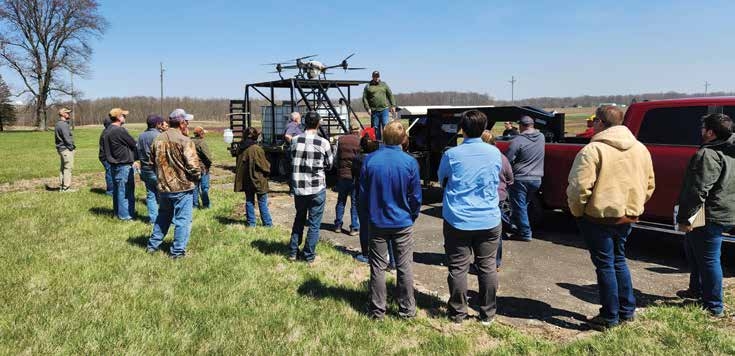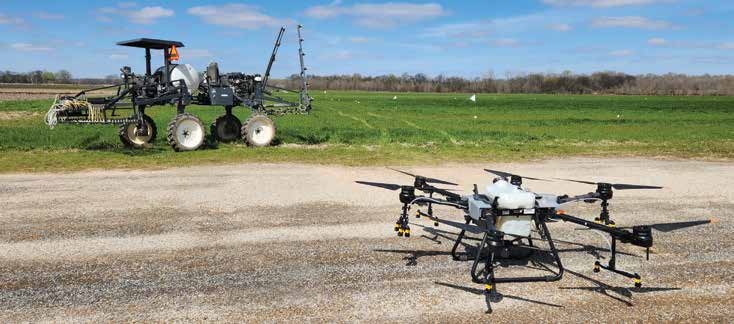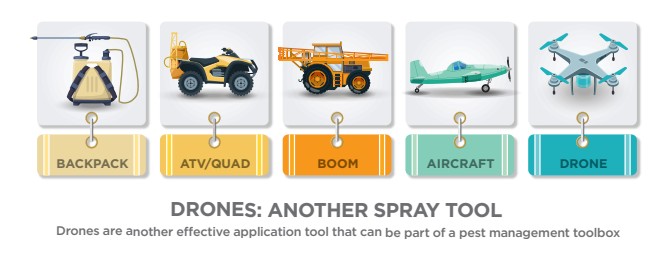14. Conclusion
RESOURCES - PUBLICATIONS
The Evolution of Spray Drones, Their Capabilities and Challenges for Pesticide Applications
14. Conclusion

Attending classroom lectures and field demonstrations are good ways to find the newest information. Keeping current is important because drone technology changes so quickly
The drone application industry is evolving so quickly that new models are becoming available as quickly as smartphones and other consumer electronics — and, like phones, they are becoming obsolete after a few years. This is what makes buying drones so different than buying ground sprayers, which you know can be used for decades to come.
Still, drones present new opportunities for making pesticide applications that we have not had before. Drones are viable and have been effective in other countries for a long time, like farmers in Japan who use them to spray rice fields.
Using drones for pesticide applications is mostly positive because it checks a lot of boxes that we have been unable to do with traditional ground and aerial equipment. Drones have become very versatile tools used across many different application sites beyond traditional agriculture.
We have seen spray drones used for forestry, mosquito control programs, container nurseries, vegetable crops, invasive weeds, roadside spraying, greenhouses, fly control in dairy operations, and organic production. However, drones require specific calibration procedures, application considerations, and insurance — commercial operations, in particular, require these things to use drone technology legally, safely, and effectively.

 Spray drones are unique pieces of application equipment compared to ground boom equipment. Researchers are evaluating drones to find optimum use practices.
Spray drones are unique pieces of application equipment compared to ground boom equipment. Researchers are evaluating drones to find optimum use practices. While spraying with drones has many positive attributes, it is unlikely that they will replace ground rigs, spray planes, or helicopters in the foreseeable future. However, drones complement these other application methods precisely because there are situations where drones are a better fit than other methods. Traditional aircraft or ground sprayers can generally cover more acres in a day because they travel faster, have wider spray widths, and can carry greater payloads. When weather conditions are ideal and operators must cover many acres, ground rigs, airplanes, and helicopters typically are more effective.
However, we should not undervalue drones because they likely will evolve into another critical tool to augment ground, water, or aerial applications. In some cases, using drones to spray pesticides could be the only viable and safe option we may have.
There are many unknowns the research community will need to address if drone applications of pesticides and other inputs will achieve the same successes everyone is hoping for. Drones are a different type of aircraft, designed differently, and have significant differences in how they spray compared to traditional fixed-wing agricultural spray planes and helicopters. Ongoing research at many research institutions around the world is currently identifying those differences.
Technological advances and improvements are made through more research and testing. Designs, spray characteristics, regulations, and business models are also subject to change considerably as more research and testing pave the way for technological advances and improvements.
A 21st Century Career Opportunity
Does the next generation of the workforce have experience with handheld controllers, joysticks, and software systems? We could never be more confident of an emphatic “yes.”
Drones will attract a new generation of employees who are computer and technology savvy. Ag technology companies and government agencies will use their skills to provide valuable insights on using this mode of application to its fullest.
Notes from the Field
A drone operator indicated:
“I encourage people to not be threatened by this new technology.
“Rather, think through how drones can supplement or improve what we are currently doing. Also do not look only at what it is now, but what it could be in the future.”
This new research will undoubtedly help create new science-based guidelines that will guide spray drone operators. The good news is that (as application scientists mention) drone platforms have more in common with each other than they have differences.
If we look back only a few years, we see that drones could only do small fields or certain high-value applications. Today, a pilot can spray a couple hundred acres or more when conditions are right. Spray drone technology will continue to evolve as the customer base increases and demand increases for more features and practical applications. This means that current pilots (with or without much experience) will be required to keep current with changing technology.
The benefits of using spray drones with today’s technologies outweighs the many concerns just raised. We are just seeing the tip of the iceberg when it comes to what we can do with drones. Keep your nose up and stay tuned.

